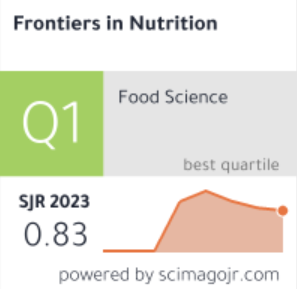老年人和年轻人对葡萄糖甜味强度的时间强度感官特征的差异
IF 4
2区 农林科学
Q2 NUTRITION & DIETETICS
引用次数: 0
摘要
背景为了了解日常生活中与年龄有关的甜味感知变化,了解阈上水平的味觉强度非常重要。以前的研究试图从时间强度评估的角度来描述人类味觉感知的时间方面。对于咸味,老年人对动态味觉强度的感知会缓慢增加;但对于甜味,以前还没有关于老年人时间强度感官评价的研究。我们假设老年人对甜味强度的感知比年轻人更慢。方法50 名年轻人和 40 名老年人参加了研究,并使用 0.6 M 和 1.5 M 的葡萄糖溶液作为刺激物。研究包括两个实验:(1)杯中品尝测试(口腔中的静态味觉感知),以及(2)时间强度感官评估,其中溶液是通过定制的传送系统传送的。口内装置是根据每位受试者的牙齿情况制作的。此外,在设计口内装置时还考虑了每位参与者的吞咽反射水平。一根吸管横跨舌后部靠近喉咙的位置,用于吸出溶液和唾液。结果与年轻人相比,老年人在两种浓度下的最大强度时间和斜率都有显著差异(1.5 M 的斜率,p &;lt;0.01;其他,p &;lt;0.05)。结论我们得出结论,老年人感知甜味的速度比年轻人慢,但最终感知到的甜味强度与年轻人几乎相同。这是首次报道老年人对葡萄糖甜味强度的时间强度特征。通过使用标准化系统,我们能够实时评估和比较不同年龄组的味觉强度反馈。在此基础上,我们建议老年人 "细细品味",以感知与年轻人相同的甜味。本文章由计算机程序翻译,如有差异,请以英文原文为准。
Differences in time–intensity sensory profiles of sweet taste intensity of glucose between older and young adults
BackgroundTo understand age-related changes in sweet taste perception in daily life, it is important to understand taste intensity at the suprathreshold level. Previous studies have attempted to characterize the temporal aspects of human taste perception in terms of time–intensity evaluations. The perception of dynamic taste intensity in older adults increases slowly for salty taste; however, there have been no previous studies on time–intensity sensory evaluation of sweet taste in older adults. We hypothesized that older adults perceive sweet taste intensity more slowly than young adults.MethodsFifty young and 40 older adults participated in the study and glucose solutions of 0.6 M and 1.5 M were used as stimuli. The study comprised two experiments: (1) a cup tasting test (static taste perception in the mouth), and (2) a time–intensity sensory evaluation, in which the solutions were presented using a custom-made delivery system. The intra-oral device was made to fit each participant’s dentition. Further, the level of gag reflex was taken into consideration for each participant in the design of the intra-oral device. A suction tube was placed across the posterior tongue near the throat to remove solution and saliva. The solution delivery system was controlled by an original computer program.ResultsOlder adults presented significantly different maximum intensity timing and slope for both concentrations compared with young adults (slope for 1.5 M, p < 0.01; others, p < 0.05). No significant differences were found between the older and young adults for reaction timing and maximum intensity.ConclusionWe conclude that older adults perceived sweetness more slowly than young adults, and ultimately perceived almost the same intensity as young adults. This is the first reported characterization of the time–intensity profile of sweet taste intensity of glucose in older adults. Using a standardized system enabled us to assess and compare feedback on taste intensities among different age groups in real-time. Based on this, we recommend older adults “savor” to perceive sweet tastes at the same level experienced by young adults.
求助全文
通过发布文献求助,成功后即可免费获取论文全文。
去求助
来源期刊

Frontiers in Nutrition
Agricultural and Biological Sciences-Food Science
CiteScore
5.20
自引率
8.00%
发文量
2891
审稿时长
12 weeks
期刊介绍:
No subject pertains more to human life than nutrition. The aim of Frontiers in Nutrition is to integrate major scientific disciplines in this vast field in order to address the most relevant and pertinent questions and developments. Our ambition is to create an integrated podium based on original research, clinical trials, and contemporary reviews to build a reputable knowledge forum in the domains of human health, dietary behaviors, agronomy & 21st century food science. Through the recognized open-access Frontiers platform we welcome manuscripts to our dedicated sections relating to different areas in the field of nutrition with a focus on human health.
Specialty sections in Frontiers in Nutrition include, for example, Clinical Nutrition, Nutrition & Sustainable Diets, Nutrition and Food Science Technology, Nutrition Methodology, Sport & Exercise Nutrition, Food Chemistry, and Nutritional Immunology. Based on the publication of rigorous scientific research, we thrive to achieve a visible impact on the global nutrition agenda addressing the grand challenges of our time, including obesity, malnutrition, hunger, food waste, sustainability and consumer health.
 求助内容:
求助内容: 应助结果提醒方式:
应助结果提醒方式:


